Type J Thermocouple: The type J is also very common. It has a smaller temperature range and a shorter lifespan at higher temperatures than the Type K. It is equivalent to the Type K in terms of expense and reliability.
Type J Temperature Range:
 Thermocouple grade wire, -346 to 1,400F (-210 to 760C)
Thermocouple grade wire, -346 to 1,400F (-210 to 760C)- Extension wire, 32 to 392F (0 to 200C)
Type J Accuracy (whichever is greater):
- Standard: +/- 2.2C or +/- .75%
- Special Limits of Error: +/- 1.1C or 0.4%
Consideration for bare wire type J thermocouple applications:
- The Type J Is Well Suited To Oxidizing Atmospheres
Type J Thermocouple Reference Table
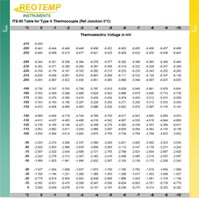
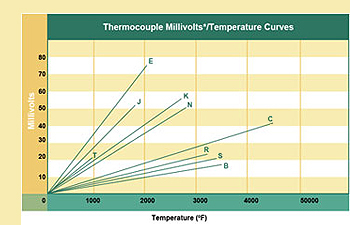
Type K Thermocouple (Nickel-Chromium / Nickel-Alumel): The type K is the most common type of thermocouple. It’s inexpensive, accurate, reliable, and has a wide temperature range. The type K is commonly found in nuclear applications because of its relative radiation hardness. Maximum continuous temperature is around 1,100C.
Type K Temperature Range:
 Thermocouple grade wire, –454 to 2,300F (–270 to 1260C)
Thermocouple grade wire, –454 to 2,300F (–270 to 1260C)- Extension wire, 32 to 392F (0 to 200C)
Type K Accuracy (whichever is greater):
- Standard: +/- 2.2C or +/- .75%
- Special Limits of Error: +/- 1.1C or 0.4%
Consideration for bare wire type K thermocouple applications:
- The Type K Is Well Suited To Oxidizing Atmospheres
Type K Thermocouple Reference Table
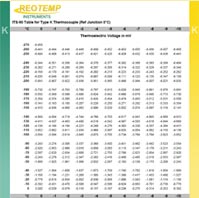

Type T Thermocouple (Copper/Constantan): The Type T is a very stable thermocouple and is often used in extremely low temperature applications such as cryogenics or ultra low freezers. It is found in other laboratory environments as well. The type T has excellent repeatability between –380F to 392F (–200C to 200C)..
Type T Temperature Range:
 Thermocouple grade wire, -454 to 700F (-270 to 370C)
Thermocouple grade wire, -454 to 700F (-270 to 370C)- Extension wire, 32 to 392F (0 to 200C)
Type T Accuracy (whichever is greater):
- Standard: +/- 1.0C or +/- .75%
- Special Limits of Error: +/- 0.5C or 0.4%
Consideration for bare wire type T thermocouple applications:
- The Type T Is Well Suited To Oxidizing Atmospheres
Type T Thermocouple Reference Table
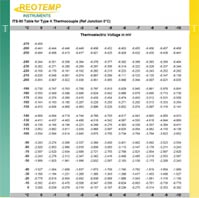

Type N Thermocouple (Nicrosil / Nisil): The Type N shares the same accuracy and temperature limits as the Type K. The type N is slightly more expensive. The type N has better repeatability between 572F to 932F (300C to 500C) compared to the type K.
Type N Temperature Range:
- Maximum continuous operating temperature: up to 2,300F (1,260C)
 Short term use: 2,336F (1,280C)
Short term use: 2,336F (1,280C)- Thermocouple grade wire, -454 to 2300F (-270 to 1,260C)
- Extension wire, 32 to 392F (0 to 200C)
Type N Accuracy (whichever is greater):
- Standard: +/- 2.2C or +/- .75%
- Special Limits of Error: +/- 1.1C or 0.4%
Consideration for bare wire type E thermocouple applications:
- The type N holds up better to oxidation at high temperatures when compared to the type K.
Type N Thermocouple Reference Table
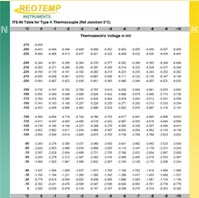

Type E Thermocouple (Nickel-Chromium/Constantan): The Type E has a stronger signal & higher accuracy than the Type K or Type J at moderate temperature ranges of 1,000F and lower. The type E is also more stable than the type K, which adds to its accuracy.
Type E Temperature Range:
- Thermocouple grade wire, -454 to 1600F (-270 to 870C)
 Extension wire, 32 to 392F (0 to 200C)
Extension wire, 32 to 392F (0 to 200C)
Type E Accuracy (whichever is greater):
- Standard: +/- 1.7C or +/- 0.5%
- Special Limits of Error: +/- 1.0C or 0.4%
Consideration for bare wire type E thermocouple applications:
- In oxiding or inert atmospheres the operating range is roughly –418F to 1,652F (–250C to 900C).
Type E Thermocouple Reference Table
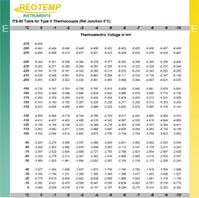

Type B Thermocouple (Platinum Rhodium – 30% / Platinum Rhodium – 6%): The Type B thermocouple is used in extremely high temperature applications. It has the highest temperature limit of all of the thermocouples listed above. It maintains a high level of accuracy and stability at very high temperatures. The type B has a lower output than the other noble metals (type R & type S) at temperatures below 1,112F (600C).
Type B Temperature Range:
- Thermocouple grade wire, 32 to 3100F (0 to 1700C)
 Extension wire, 32 to 212F (0 to 100C)
Extension wire, 32 to 212F (0 to 100C)
Accuracy (whichever is greater):
- Standard: +/- 0.5%
- Special Limits of Error: +/- 0.25%
Type B Thermocouple Reference Table
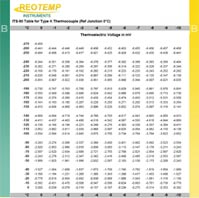

Type R Thermocouple (Platinum Rhodium -13% / Platinum): The Type R is used in very high temperature applications. It has a higher percentage of Rhodium than the Type S, which makes it more expensive. The Type R is very similar to the Type S in terms of performance. It is sometimes used in lower temperature applications because of its high accuracy and stability. Type R has a slightly higher output and improved stability over the type S.
Type R Temperature Range:
- Thermocouple grade wire, -58 to 2700F (-50 to 1480C)
 Extension wire, 32 to 392F (0 to 200C)
Extension wire, 32 to 392F (0 to 200C)
Accuracy (whichever is greater):
- Standard: +/- 1.5C or +/- .25%
- Special Limits of Error: +/- 0.6C or 0.1%
Type R Thermocouple Reference Table
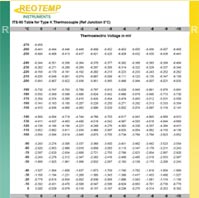

Type S Thermocouple (Platinum Rhodium - 10% / Platinum): The Type S is used in very high temperature applications. It is commonly found in the BioTech and Pharmaceutical industries. It is sometimes used in lower temperature applications because of its high accuracy and stability. The type S is often used with a ceramic protection tube.
Type S Temperature Range:
 Maximum continuous operating temperature: up to 2,912F (1600C)
Maximum continuous operating temperature: up to 2,912F (1600C)- Short term use: up to 3,092F (1,700C)
- Thermocouple grade wire, -58 to 2700F (-50 to 1480C)
- Extension wire, 32 to 392F (0 to 200C)
Accuracy (whichever is greater):
- Standard: +/- 1.5C or +/- .25%
- Special Limits of Error: +/- 0.6C or 0.1%
Consideration for bare wire type J thermocouple applications:
- The Type S can be used in inert and oxidizing atmospheres up to 2,912F (1600C) continuously and
up 3,092F (1,700C) for short term use.
Type S Thermocouple Reference Table
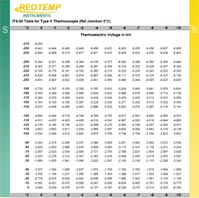





 Short term use: 2,336F (1,280C)
Short term use: 2,336F (1,280C)



 Maximum continuous operating temperature: up to 2,912F (1600C)
Maximum continuous operating temperature: up to 2,912F (1600C)


















